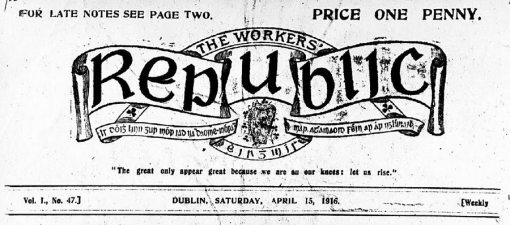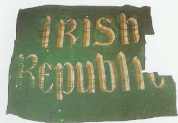“You never know if the time is ripe until you try. If you succeed the time is ripe, if not, then it was not ripe.” James Connolly, 1915.
That observation is as true today as it was in 1915. But while Connolly was prepared, one year later, to put it to the test, there is no evidence that we are prepared to do so despite finding ourselves in the most propitious moment in the past 94 years to re-establish the progressive, enlightened, Irish Republic, for the benefit of all.
Instead, we blather about the Republic but effectively do nothing to put it in place, we stare misty-eyed at the past but are myopic when looking to the future, we squabble with each other about whose method is best or interpretation more pure, we wring our hands at the degradation of our people as if we are helpless, we stand and observe as the no-mandate parties take power once again, we give out about the same-old-politics and then give in.
We have to stop doing that. The republic is there for the making, but only if we have the courage of our convictions, only if we imagine the republic as it must be today – a 21st century republic, only if we believe in it, only if we are prepared to work for it, only if we develop a strategy to win it, only if we forge the alliances with other believers that are necessary to make it a reality, and only if we explain to the people how that republic would enhance their lives in very real ways.
The cards we have been dealt favour such a project. But have we the courage and the commitment to play that winning hand?
Thanks to the centenary of the 1916 Revolution, and despite the best efforts of the political class to play that down, the people are more engaged with the notion of a republic than at any time since the 50th anniversary in 1966. The Proclamation took centre stage. In every part of the state, national school students went home one day and engaged their parents and grandparents with questions and observations about the Proclamation. In other words, the republic was smuggled into homes by children, and families talked around the table about it, and what it could mean.
In stark contrast to the ideals of the Proclamation, and the sacrifices a previous generation were prepared to make to establish the republic, the people have been presented with all of the signs of an utterly failed state in which crisis follows crisis and scandal follows scandal, in which incompetence is rewarded and jobbery and corruption excused, in which obfuscation and the cover-up are the norm, in which private interests trump the public good, in which (Catholic) church and state are still inseparable, in which grotesque inequality is evident at every turn, and in which the norms of a true democracy are routinely thrashed.
But this is a republic, they tell us. Yes, in the same way as a dodgy car salesman turns a clapped-out Nissan Micra into a Mercedes by sticking a Mercedes badge on it. This is not a republic.
All over this country good people, decent people, caring people, work alone or in groups on issues of real public concern. They labour under the illusion that engagement with the regime can bring about meaningful change. They assemble in protest outside parliament, imagining that some notice will be taken – but are viewed from behind the windows of Leinster House as just noisy gnats. Some make it into Leinster House and emerge satisfied that some politician or other has leaned towards them to say “I’ll do what I can for you’ – with all of the sincerity of a snake-oil salesman. The system is not designed to resolve issues of pressing concern to citizens who are not part of the political class. We know this to be true.
In a properly constituted progressive republic things will be very different. The republic is owned by the people and not by any ideological sect. The republic is founded on immutable principles of Liberty, Equality and Solidarity. Think about each of those words in their wider meaning, the private as well as the public – the personal as well as the national, and it becomes obvious that the republic cannot exist if it doesn’t strive at all times, under the direction of the people through genuine democratic engagement, to vindicate those principles.
Women must be well aware that under the current regime – the latest manifestation of a continuous conservative regime stretching back to the foundation of the state – there is no possibility of achieving real equality with men or true personal autonomy in mind, spirit and body. In a republic, drawing on the promise of the Proclamation and based on those three republican foundational principles, women’s equality with men and their personal autonomy, their liberty, will be a given – otherwise the republic cannot exist.
The same is true of those sections of society that suffer economic disadvantage and impoverishment, including deprivation in housing, health, nutrition, education, employment and opportunity. Their status will remain the same under the current regime, driven as it is by corporatism – rampant capitalism – a false ideology that demands that a precious resource is thrown on the scrap-heap as if that makes any economic sense, to say nothing of the ethical/moral dimension of such oppression. The republic will work assiduously to correct that gross imbalance and injustice, otherwise the republic cannot exist.
The same applies across a whole range of social, economic, justice and human rights issues. The current regime working as always in the interest of a powerful minority will not resolve, for instance, the issue of Travellers’ rights, or of the rights of those in Direct Provision, or the rights of those suffering mental ill-health, or of those forced into emigration, or a host of other big and small issues, which in a republic will have to be resolved – otherwise the republic based on those three principles cannot exist.
The same applies in the area of foreign policy, international relations and our place in the world. While the majority of our people express support for neutrality and non-engagement in wars, the state is busy dismantling a too-vague expression of neutrality and moving towards NATO involvement while simultaneously facilitating US wars in the Middle-East. An ethical republic would present itself internationally as peace keepers and facilitators of conflict resolution. It would also present itself as committed to resolving international issues around the environment, sustainability, resources, justice and freedom from oppression.
If we want to correct the failures of this state then the progressive enlightened republic, with a constitution fit for a republic and supported by the people, is the only viable option. The Proclamation and its further development in the Democratic Programme passed by the Dáil in January 1919 provide us with an initial template to follow. A modern constitution worth examining is the Constitution of the Bolivarian Republic of Venezuela. The preparation of an initial draft constitution of the Irish Republic is well within the scope of civil society groups and individuals to achieve in the coming year.
Can we win democratic support for the creation of the progressive republic? I firmly believe we can, if that is what we want to – and intend to – achieve.
The recent general election showed that politics is in a state of flux, that the people have thrown off the habits of the past in sufficient numbers to fracture the hegemony enjoyed since 1922 by the two conservative-capitalist parties, Fianna Fáil and Fine Gael, supported when necessary by the Labour Party. Support for those two parties is now below 50%, while there is now a solid core of left/republican parties, groups and individuals in parliament.
The Right2Change initiative was an important element in provoking that shift among sections of the electorate, and will be in the run-up to the next election. Its one failing – and this is not a criticism – was in not being able, not least because of time-constraints but also because of disunity among its community pillar, to find and support a community R2C candidate in every constituency. That strategy of having a non-party citizen-candidate is important in the context of an antipathy among sections of society to Sinn Féin and other parties of the Left, exacerbated and exploited by a hostile media on behalf of the political class of which senior media operatives are an important part and are beneficiaries in maintaining the status quo.
We will have an election in the near future. It may be in six months, or eighteen months, or at a stretch two years. If we get to work now we can be in a position to fight for a seat in every constituency for a non-party candidate who is committed to the idea of creating that progressive enlightened republic. Ten extra seats for the progressive republic would tip the balance in its favour. To achieve that we will need a body of Citizens for the Republic as soon as possible in every constituency, explaining the basis of the republic and the benefits for the great mass of people of its reinstatement, encouraging people to talk around the table about the republic with family and friends and to engage with others to spread the good message about the republic and the great boon it would bring to our lives.
All elements of civil society – NGOs, organisations, voluntary groups and individuals – have a key part to play in spreading that message. The republic is the only place that we get to realise our ambitions, that we resolve issues, that we create a true democracy – the republic owned by the people. We are capable of realising James Connolly’s ambition for the republic, that it would act as a beacon of hope for oppressed people around the world.
First imagine the republic, understand it, believe in it, then go to work for it. Tap into the goodwill that exists for it thanks to this centenary year. Mine the myriad failures of the state to correct serious problems affecting so many in society across a range of issues and so often involving personal catastrophes. Forge the republic!
I began with Connolly’s quote. Let me end with a quote from a very different individual, W B Yeats – but in essence the same message!
“Do not wait to strike till the iron is hot; but make it hot by striking.”


